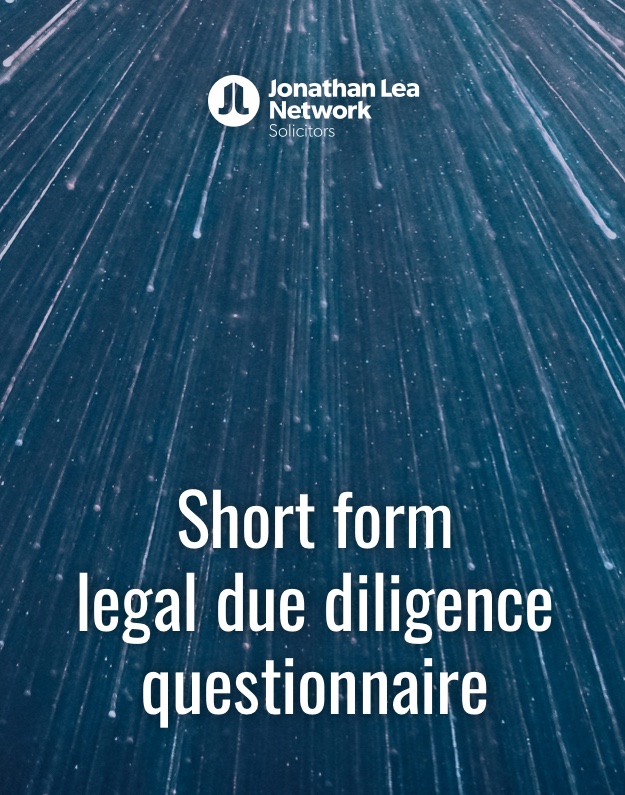Short form legal due diligence questionnaire
£9.99
This product constitutes an easily adaptable, short form, legal due diligence questionnaire for use in relation to share purchases, together with a set of tailored guidance notes explaining some of the key aspects.
This document contains short form legal due diligence enquiries relating to the acquisition of the entire issued share capital of a private limited company. Its purpose is to assist the buyer and/or their solicitors in obtaining information and copy documents from the seller for the purposes of carrying out legal due diligence on the proposed acquisition.
Further down the page are our guidance notes relating to this template which you will also receive as a separate document when you buy the product.
Guidance notes for short form legal due diligence questionnaire (share purchases)
This guide aims to explain the purpose of a due diligence questionnaire / checklist and also sets out some points to note, as well as providing some general information as to the purpose and nature of the due diligence exercise.
What is the purpose of the due diligence exercise?
The term “legal due diligence” refers to the work undertaken by the buyer or their solicitors to investigate certain legal affairs of the target company.
The information received in response to this legal due diligence questionnaire should assist the buyer in making an informed assessment of the potential risks and rewards of the proposed acquisition.
Following receiving the responses to the questionnaire, the buyer can then determine whether it is appropriate to:
- Proceed with the transaction on the basis of the negotiated terms;
- Seek to renegotiate the terms of the acquisition to reflect any issues or liabilities identified during the due diligence process (for example, asking for a decrease in the purchase price); or
- Withdraw from the transaction.
In addition to identifying any issues that may affect the buyer’s decision to proceed with the transaction (or the terms on which it is prepared to proceed), the information revealed during the legal due diligence exercise will assist the buyer and its legal advisers in determining the scope of the warranties (the contractual promises) that should be included in the share purchase agreement, as well as any areas of risk where specific indemnities may be necessary.
The purpose of a due diligence questionnaire
Please note that the due diligence questionnaire we have provided is a short form version and is intended to be used on share purchase transactions (not asset purchases). The questionnaire is intended for use in connection with the acquisition of the entire issued share capital of a private limited company.
The due diligence questionnaire is intended for use in transactions where the target company’s affairs are straightforward or where the buyer does not require an extensive legal due diligence review to be undertaken.
It is important to ensure that the content of the legal due diligence questionnaire is relevant and appropriate in the context of the transaction. The questionnaire should be tailored as necessary to reflect the circumstances of the particular transaction, in particular:
- The size, complexity and the nature of the target company’s business;
- The buyer’s perception of the degree of risk involved in the transaction its general attitude to risk;
- The time, resources and expertise available to review any information that is provided in response to the due diligence enquiries; and
- The scope of the legal due diligence review that has been agreed with the buyer.
Some of the questions included in this document will not be relevant to every transaction and care should be taken to delete any queries that are clearly irrelevant. It is common for responses to many of the questions to be “N/A” as the questions will not be applicable to every company/transaction.
Similarly, it may be necessary to expand the information request to include additional questions that focus, for example, on specific industry risks affecting the target company, or other areas of risk that are of particular concern to the buyer.
The main purpose of the due diligence questionnaire is to encourage disclosures from the seller in relation to the questions. This is so that the buyer gets a full picture as to the company that they are purchasing and so that they pay an accurate price for the target company.
In the normal sequence of events, the buyer’s legal advisers will send over a tailored / bespoke version of this legal due diligence questionnaire (i.e. tailored to fit the specifics of the transaction itself and the parties to it) to the sellers. The buyer’s lawyers will then produce a due diligence report. The due diligence report will set out clearly the responses to the due diligence questionnaire and the contents of the report will have a significant bearing on the warranties and indemnities required by the buyer.
The form and content of a legal due diligence report will vary depending on the buyer’s requirements and the transaction timetable.
The report will be divided into sections covering each area of the target business. Each issue investigated will be identified, together with the results of that investigation and any possible impact there may be for the proposed acquisition. Where possible, the report will also indicate / advise how particular issues may be practically resolved, for example by measures such as an adjustment to the purchase price of the target or by acquiring appropriate consent from a third party.
Please note that there are different kinds of due diligence reports, and the kind that is required will depend on the specifics of your transaction.
Points to note in the due diligence questionnaire
Your input is required at the parts of the questionnaire highlighted in yellow and the wording inside the square brackets which we have included explains clearly the information that should be inserted. You are advised to fill in the wording in square brackets in lower case unless directed otherwise. Any figures should be inserted in numerical form. The brackets should be removed after the amendments are made (and before sending a final version of the checklist to the seller).
Paragraph three (Accounts)
Responses to these enquiries will not provide a buyer with sufficient information to carry out a full financial due diligence investigation. As such, the buyer will need to instruct its accountants or financial advisers to carry out a separate financial due diligence investigation (the responses to the questions within this due diligence questionnaire form part of the legal due diligence exercise).
Paragraph five (Contracts and trading)
Paragraph 5.11 allows the buyer to identify any contracts with terms that are particularly onerous (paragraph 5.1(b) specifically asks for disclosure of contracts, commitments etc which are unusual, abnormal or onerous in nature). The buyer can then make the decision as to whether or not they are willing to accept the contract in its current form or identify the contract as being marked for renegotiation once the target has been purchased.
Paragraph seven (Intellectual property rights)
This paragraph enables the buyer to identify the intellectual property rights relating to the company and will identify whether the relevant protections are in place or not. It also aims to identify the owner of the IP so the buyer may ensure the company owns all of the intellectual property rights it needs to carry on its business after completion and that negotiations with the seller can start in relation to any intellectual property rights that are crucial to the functioning of the company but are the property of the seller.
Paragraph eight (Insurance)
The buyer will want to understand the insurance requirements of the target company (and any group company) to confirm that they will continue to have adequate insurance in place once it acquires the shares in the target.
Paragraph 10 (Litigation and disputes)
In order to build a complete picture of the actual and potential liabilities that any group company has, a buyer will want to know about any actual, pending or threatened litigation claims against any group company or that any group company may have.
Paragraph 11 (Real Estate)
This section seeks to identify any real property that will transfer to a buyer as part of the share purchase. The questions are intended to identify things such as the number of properties involved, any problem areas in relation to the properties and properties of key importance or high value.
Paragraph 11.1 enables the buyer to obtain a definitive list of the properties involved in the transaction. Paragraph 11.2 enables the buyer to obtain a full picture of the properties it is purchasing. The plans obtained can be used for local authority search purposes.
Paragraph 11.1(e) will elicit information relating to the leasehold properties.
Paragraph 11.5 is intentionally drafted in a broad manner so as to reveal a full picture of any problem areas associated with the properties and where there have been breaches of covenants (paragraph 11.6 also helps with this). This is important as some matters such as encumbrances are not always apparent from an investigation of title to the properties or apparent from the pre-contract searches. If any issues are revealed, the buyer may consider requesting indemnity cover or removing the problem properties from the purchase.
Paragraph 11.8 is drafted to include an element of materiality. This may be appropriate where the buyer is only concerned with material compliance. Where tenants occupy any property, there are likely to be minor breaches of covenant relating to the tenant’s covenants to repair and decorate the premises. Minor breaches rarely justify forfeiture and, in many cases, would not give rise to any substantial claim for damages.
Paragraph 11.9 is intended to identify any properties that are not used exclusively by the seller for the purposes of the business. If any such properties are identified, the buyer and seller will have to negotiate on how these can be best dealt with and appropriate provisions will need to be inserted into the share purchase agreement.
Paragraph 11.10 will highlight any properties that the seller wishes / intends to retain. Occasionally, parties to a share purchase deal will agree that some properties are to be shared or split between them, or the seller may want to retain some of the properties for its own continued use. If this is the case, the share purchase agreement will need to include provisions to reflect the situation.
Paragraph 11.11 refers to any outstanding contracts which have not yet been completed or transfers which have not been registered. If any are revealed then provisions may need to be inserted into the share purchase agreement, for example provisions requiring the seller to complete any outstanding contracts prior to completion, or within a limited time following completion.
Paragraph 11.13 will reveal whether any of the properties have split legal and beneficial ownership, whereby the company holds legal ownership as trustee for another. This would not be apparent from the buyer’s investigation and searches, unless a declaration of trust is disclosed.
Paragraph 12 (Employees)
Paragraph 12.4 – as many terms and conditions of employment are not included within one single document or staff handbook, copies of all standard contracts of employment must be requested. As standard contract of employment are updated frequently with employees joining at different times being subject to the different versions of the same policies, procedures or handbooks, the buyer will want to assess these documents as part of its due diligence.
Paragraph 12.5 (a) – a buyer’s solicitor should check any relevant scheme rules to ensure that the takeover does not trigger claims for lost share option rights. Scheme members may cease to be eligible to participate on a share sale but may be given an exercise window or their entitlements may lapse, depending on the scheme.
Paragraph 12.9 – previous disciplinary records (even expired warnings) may be relevant to future disciplinary decisions, such as whether or not to dismiss for misconduct justifying dismissal on its own, or to redundancy selection. Grievances raised pre-sale would become a buyer’s responsibility post-sale.
Paragraph 12.13 – Union recognition remains in place on a share purchase. Recognition need not be for collective bargaining purposes. Trade unions can also have more limited forms of recognition, such as operation of check-off, the right to post notices or hold meetings in the workplace or to accompany members at disciplinary or grievance meetings. Details of applications for recognition or requests for the establishment of employee representatives or works councils will also be of interest, indicating whether this is likely to be a live issue in the future.
A share purchase is likely to trigger obligations to consult a buyer or seller’s domestic or European works council or information and consultation body. A buyer may be keen to ensure a seller complies with its obligations, to avoid inheriting a disgruntled workforce.
Paragraph 15 (Pensions)
The pensions enquiries in this due diligence questionnaire are general and should be amended as necessary to reflect the circumstances of the relevant transaction (and relevant pension scheme).
Not every enquiry will be relevant to every pension scheme, and also if the buyer is not taking on the scheme.
The obligations of a buyer to provide pensions to employees depends on the company’s pensions arrangements.
If a buyer operates its own group personal pension scheme there may also be practical issues relating to the harmonisation of benefit and provision in the future.
Paragraph 16 (Environment)
Once a transaction has commenced, one of the cardinal components of the buyer’s due diligence investigations (in any share or asset acquisition) is identifying and understanding environmental risks. For example, the buyer can acquire environmental liabilities in respect of historical land contamination and other environmental liabilities, such as liability arising for regulatory breaches under The Environmental Permitting (England and Wales) Regulations 2007, or waste legislation.
Environmental liabilities can give rise to unforeseen costs, particularly where those liabilities are not apparent. They can also give rise to criminal penalties for directors.
In some instances, at the beginning of a new transaction, the property lawyers may have sent out the standard CPSE questionnaire. It is not sufficient for a standard CPSE questionnaire to be sent to cover environmental questions, as the law has changed and continues to become increasingly onerous in respect of environmental issues.
In a share purchase transaction, the buyer will inherit, with the target company, all of its potential liabilities in respect of contaminated land. This will not be the case in an asset sale where the buyer can “cherry pick” the assets it wishes to acquire and can therefore choose to exclude any contaminated sites from the sale. Carrying out a thorough environmental due diligence exercise will therefore minimise the risk of exposure to environmental liabilities.
Paragraph 16.3 – permits are required by companies to operate installations and for discharging waste, water or air over a certain limit. It is important for the buyer to know that a permit is held by the seller and also to consider the terms of transferring any such permit.
Paragraph 16.5 – many environmental problems can arise from landfill sites and that is why this question has been included. Current landfill sites have to be permitted. Some of the local authority records do not accurately reflect landfill sites that existed prior to 1970 and the buyer should keep this in mind when reviewing any environmental information that has been provided on existing landfill sites.
Paragraph 16.7 – there are a number of criminal offences for interfering with protected species and to breeding and resting sites of protected species. Management agreements between owners or occupiers of land to manage the interests of nature conservation can potentially be onerous.
Paragraph 16.9 – under the Contaminated Land Regime the local authority has a duty to inspect the land under their control to check if it is contaminated. If the land is contaminated it has to serve a remediation notice on the ‘causer’ of the pollution. There may be communications in the form of letters prior to issuing a remediation notice, which the buyer will want to know about, as any clean up may incur substantial costs, but also affect the use of the land. The principle applies to any third parties alleging nuisance or interference with their property.
Paragraph 16.12 – the buyer will want to know that the seller has enough allowances for the projected emissions and how much will have to be spent on obtaining additional allowances.
Paragraph 16.13 – although a company may hold public liability policies, nearly all of these issued or renewed since 1990 have excluded cover for gradual pollution. Bespoke environmental insurance is available and the buyer’s solicitor should check the terms of cover, as it may meet environmental liabilities that may fall on the insured.









